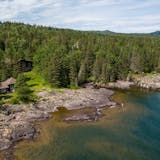More than three decades after last renovating Como Lakeside Pavilion, St. Paul officials are gauging local, state and federal interest in what could be the most substantive transformation of the local landmark in more than a century.
City Council President Amy Brendmoen, who is not running for re-election this fall, is leading the charge to expand and renovate the pavilion to not only make it more accessible, but also take greater advantage of its prime location on the north shore of Como Lake. She said she's hoping to build support for a project that the next City Council can move forward.
"The world has changed a lot between those two periods [construction and the last renovation], and we just want to really look at it from the inside out and figure out how to set us all up for success and better access," Brendmoen said.
Preliminary plans and renderings were unveiled Tuesday night at a District 10 Como Community Council meeting. The idea is to get the community thinking of ways to improve the site as a dining, entertainment and recreation venue for decades to come, said Brendmoen, who represents the area.
"I guess we're calling it 'a vision for improvement of Como Lakeside Pavilion,'" she said of three renovation scenarios — showing possible minimal, moderate and extensive changes — presented Tuesday night. "I think we all agree that there's room for improvement."
While the renderings are just a starting point for discussion, it's possible that an expansion and transformation of the pavilion could be included in city capital improvement plans for 2024, said Andy Rodriguez, Parks and Recreation director.
"It's one of the most iconic structures we have in the park system," Rodriguez said, noting that Como Regional Park is the busiest in the city and one of the busiest in the state. "It's a very visionary design. People seem excited by it."
Molly Maher, who has for several years booked music groups at the pavilion and hosts the Lakeside Guitar Festival there every August, said the pavilion is a beautiful facility — but one with challenges. It could use more space behind the stage, she said, and the stage itself should be expanded to handle musical groups of various sizes.


